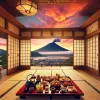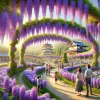Hi everyone, Mark here! I'm a seasoned backpacker with a serious passion for exploring Asia's vibrant cities and hidden gems. This time, I'm taking you on a journey through the captivating landscapes and rich culture of Japan's Shikoku region, specifically the enchanting island of Shodoshima, and beyond. Forget the bustling crowds of Tokyo and Osaka; let's delve into the authentic heart of Japan.
Shodoshima: A Taste of Rural Japan
Shodoshima, a small island in the Seto Inland Sea, is a true hidden gem. Its central plateau, the Shiho-sashi Observatory, offers breathtaking panoramic views extending up to 60 kilometers. From there, you can witness the majestic Seto-Ohashi Bridge connecting Honshu and Shikoku, the stunning views of the Seto Inland Sea, and even the Kankakei Gorge, one of Japan's three great gorges.
Many Japanese TV shows feature "Going to the countryside to stay overnight," and Shodoshima embodies that perfectly. It's not just about stunning scenery; it's about experiencing authentic Japanese rural life. The island boasts a 400-year-old tradition of soy sauce making and hand-stretched udon noodle production. This is where you come to savor traditional Japanese flavors passed down through generations. It's the embodiment of "old-fashioned taste," reflecting centuries of culinary heritage. The spring season offers the added bonus of cherry blossoms, making it a truly unforgettable trip.
My Approach to Japanese Travel: Embracing Spontaneity
One thing I've learned from countless trips is to ditch rigid itineraries. I don't pre-book restaurants. I prefer the thrill of discovering local eateries, from small family-run restaurants (shokudo) to bustling food stalls. Whether it’s a Michelin-starred restaurant or a hole-in-the-wall joint, tasting local flavors allows me to connect with the regional culture, often reflected in the ingredients themselves. While some travelers might find this approach chaotic, for me, it’s the essence of adventure. Travel is not a contract; it’s a dialogue with the environment, an immersion into the very fabric of a place.
Shodoshima's Culinary Delights: Olive Beef and More
Shodoshima offers unique culinary experiences. Olive beef, raised on a diet of olive pulp, is a local specialty with a distinct, unforgettable flavor. The island's cattle farming history stretches back over 1,000 years! The best dishes aren't always found in fancy restaurants; often, the most authentic tastes are discovered in humble roadside eateries. Simple dishes like udon noodles, olive oil, and rice balls leave a lasting impression.
Exploring Shodoshima's Unique Attractions: From Film Sets to Festive Flags
Our journey continued to the 24-Eyes Movie Village, a charming site preserving the sets of an old Japanese film. It provides a glimpse into the rural Japan of the Showa era. We also witnessed the vibrant beauty of Koinobori (carp streamers), typically displayed during Children's Day (May 5th). These colorful flags symbolize children's health, growth, and bright futures, drawing inspiration from the Chinese legend of carp leaping over the Dragon Gate.
| Location | Description | Highlight |
|---|---|---|
| Shiho-sashi Observatory | Panoramic views of the Seto Inland Sea and surrounding islands. | Breathtaking 60km views |
| 24-Eyes Movie Village | Preserved film sets depicting rural Japan during the Showa era. | Step back in time |
| Kankakei Gorge | One of Japan's three great gorges. | Stunning natural beauty |
| Olive Beef | Locally raised beef fed on olive pulp, resulting in a unique flavor. | A must-try culinary experience |
Kurihama Park: A Michellin-Starred Garden
Next, we explored Kurihama Park, a three-Michelin-starred garden established around 1625. This expansive park, surprisingly devoid of chestnut trees (despite its name), features over 1400 meticulously pruned pine trees, many sculpted by master craftsmen (shokunin). The park utilizes the technique of "borrowed scenery," incorporating the distant Mount Shiunzan into its design. With its blend of Chinese, Western, and Japanese elements, the park provides a visually stunning and serene experience, particularly during the spring cherry blossom season or autumn's foliage.
Understanding Japanese Architecture: Elevated Floors and Tatami Mats
The elevated floors common in Japanese houses serve a practical purpose: protecting against dampness and maintaining cleanliness. The raised platform creates a buffer between the floor and the ground, reducing moisture damage and keeping the interior cleaner. Combined with tatami mats, this design minimizes dirt and maintains a hygienic living space.
Kurashiki Bikan Historical Quarter: A Glimpse into Japan's Trading Past
Our adventure took us to Kurashiki Bikan Historical Quarter in Okayama Prefecture. This beautifully preserved area, with its 400-year-old buildings lining the Kurashiki River, offers a captivating glimpse into Japan's past. The name Kurashiki literally means "warehouse village," reflecting its historical role as a vital trading and storage center. Its blend of old-world charm and modern amenities makes it a popular destination for tourists eager to experience authentic Japanese culture.
The Tottori Sand Dunes Museum: A Unique Art Experience
The Tottori Sand Dunes, featuring the world-renowned Tottori Sand Museum, offer an unexpected art experience. Created with sand reclaimed from local road construction projects, the museum showcases stunning sand sculptures by international artists. This sustainable approach to art makes it even more unique. The museum changes its theme annually, attracting art enthusiasts from around the globe. The museum's stunning location, adjacent to the magnificent Tottori Sand Dunes, a designated World Geopark, is a further highlight.
Exploring Bird View: Cherry Blossom Secret Spots and Castles
Our journey also included a visit to some off-the-beaten-path locations, like the Kuno Castle Ruins Park in Tottori Prefecture, a hidden gem known for its stunning night cherry blossoms. This park, along with other castle ruins in the region, preserves the remnants of the past, offering a tranquil setting for appreciating the beauty of nature and history. The park also features a magnificent array of Yoshino cherry trees.
The Serenity of Mokudani Stream and Hiroshima Peace Memorial Park
Finally, we visited Mokudani Stream, renowned for its pristine beauty, and the Hiroshima Peace Memorial Park, a poignant reminder of the destructive power of war and a symbol of peace and hope for the future.







